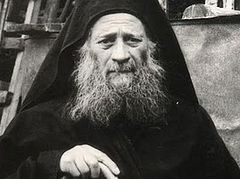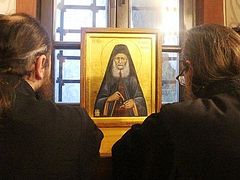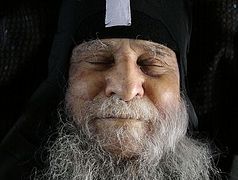Hieromonk Ephraim is a longtime disciple of Elder Ephraim of Arizona who received the elder’s blessing to live and struggle ascetically at St. Nilus Island Skete, near Kodiak, Alaska. Fr. Ephraim as offered us the fruit of his hagiographic labors on the windswept isle for our readers’ edification.
We begin today with Part 1, his introduction.
St. Joseph the Hesychast was one of the greatest monks of the Holy Mountain in the 20th century. His life story and teachings have been translated into many languages and touched thousands of people. People have been moved especially by the stories told by his disciple, Elder Ephraim of Arizona, in the book My Elder Joseph the Hesychast. Due to the popularity of this book, I was asked to write this article, explaining the story behind it. In Part 2, Part 3, and Part 4 of this article, I will share some unpublished anecdotes about St. Joseph.
When I was a monk at Philotheou Monastery, I had access to more than 100 private cassette recordings of Elder Ephraim's homilies to us his monks. In them he taught both basic and advanced aspects of the spiritual life, and he illustrated his teachings with examples from lives of the saints and especially from the life of his holy elder, St. Joseph. I found the stories about St. Joseph to be so inspiring that I wanted to share this treasure with other people. So in the year 2000, I asked Elder Ephraim if I could type up all the stories about St. Joseph from his homilies and organize them into a biography, and he gladly gave me his blessing. I then spent an entire year listening to all his homilies and typing word for word what he had said about his elder, St. Joseph. During that year, I also typed up verbatim numerous accounts of other people who had lived with St. Joseph—primarily St. Ephraim of Katounakia and Elder Haralambos of Dionysiou. But since most of the stories I had gathered were from Elder Ephraim of Arizona, I put him as the author of this composite book.
The result of all this work was a 700-page biography of St. Joseph in Greek. I shared this with our abbot at St. Anthony’s Monastery, Archimandrite Paisios, and based on the research he had done, he improved the text by clarifying and correcting some aspects of St. Joseph’s life as a layman. I also shared this rough draft with our other monasteries established by Elder Ephraim. Fr. Anthony (a hieromonk of St. Anthony's Monastery) also saw my rough draft and received the blessing of Elder Ephraim to expand it. He added many valuable historical details to give the reader a better understanding of the world that St. Joseph lived in. He also elaborated on my rough draft by adding several pertinent quotes from the holy Fathers. Furthermore, he found dozens of photographs and inserted them throughout the text.
At this point, the book was basically ready for publication. But since an important book like this needs to be polished as much as possible before being published, I wanted to find a native speaker of Greek who could go through the entire book and elevate the linguistic style wherever needed, and also improve any abrupt transitions between paragraphs, etc. So I sent this rough draft to two of our monasteries in Greece, but neither of them could find the time to edit and publish it. Finally, after the book remained in limbo for several years, Fr. Stephanos Anagnostopoulos of Piraeus decided to tackle this enormous task of proofreading, polishing, and publishing. He carefully went through the version of my draft that was expanded by Fr. Anthony, and he improved the overall flow and feel of the text. He also added more information about the nuns of St. Joseph. Thus, in 2007 he completed the work and published it in Greek. After he published it, St. Joseph appeared to him in a dream and embraced him, clearly showing how pleased St. Joseph was with his labors.
Once the Greek version of the book was published, I was asked to translate it into English. But as I began translating the book, I started to notice some problems with it. Not only were there many stories missing from my original rough draft, but there were even some additions that were clearly added just to spice up the original story. For example, in the incident where St. Joseph as a child obediently approached his father when he said that he would spank him, the published Greek text adds that his father was so moved by his son’s obedience that he had tears in his eyes. This detail did not exist in the original source but was added by the editors.
Another such addition made was to the following vision of St. Joseph (which was not included in the English edition of his biography) as narrated by St. Ephraim of Katounakia: “After a long fast, St. Joseph had a vision in which he saw the Holy Mountain as if it were a table supported by three legs. One of the legs had completely collapsed, and another was also ready to fall. The third was still standing, and the entire table was supported by it alone. The angel who was showing this table to him said to him: ‘This is the Holy Mountain.’ He saw this vision around 1930. Many years have passed since then. As for how the Holy Mountain is now, only God knows.” This is how St. Ephraim of Katounakia told this story. But the editors of the Greek edition of St. Joseph’s biography added to the angel’s words the following sentence: “This is what is supporting Orthodoxy.”
As for the stories that were missing from my original rough draft, it appears that the editors of the published book in Greek were concerned that revealing the human side of St. Joseph (such as his struggle to overcome anger) would detract from his holy reputation. Therefore, they chose to omit such stories. They also omitted how Elder Ephraim fought against carnal thoughts. But I, on the contrary, believe that it is precisely these struggles that we struggling Christians need to see. By seeing how they fought temptations, we can learn from their example. Besides, when a biographer presents a saint as being someone who was always perfect, not only do we lose the ability to relate with him, but even more dangerously we can fall into the error of believing that spiritual progress is out of our reach. For if the saints were always perfect, then we who are very imperfect have no hope of becoming even somewhat like them. Therefore, because of all this, and because I believe that people benefit from the truth, I decided to include all those omitted stories when translating this book into English.
I also noticed that a few human errors had slipped into the final published Greek edition. For example, in the incident of Fr. Athanasios pondering whether or not St. Joseph had made a mistake in his decision to side with the monasteries on the calendar issue, the original text in my rough draft (taken verbatim from Elder Ephraim) had Fr. Athanasios saying to himself: “Ἄραγε, λέει καλὰ ὁ Γέροντας; Δὲν λέει καλὰ ὁ Γέροντας;” (“I wonder, is Geronda right? Is Geronda wrong?”) But in the subsequent draft of the Greek edition, the second question mark in this phrase was accidentally replaced with a period, which changes the meaning to: “I wonder, is Geronda right? Geronda is wrong.” And then in the printed Greek edition, the final period in this quote was replaced with three exclamation points: “Geronda is wrong!!!”
Before I finished translating the book into English, Abbot Symeon Gagatyk from Ukraine came to Arizona in 2010 to find out more about St. Joseph and to translate his published biography from Greek into Russian. I explained to him the above history of this book, and I gave him both my original rough draft and Fr. Anthony's expanded version as well as the published Greek edition, so that he could see for himself how the text evolved and so that he could choose the best parts of each of the three versions to translate into his Russian edition. After comparing those two drafts with the published Greek edition, he concluded that my original rough draft was the most accurate version, and he proceeded to translate it into Russian. One significant change he made in his Russian edition was to separate the book into two parts instead of keeping the events in chronological order. He also decided to change the title of the book in Russian from "My Elder Joseph the Hesychast" to "My Life with Elder Joseph."
As for the publication of this book in other languages (Romanian, Georgian, Arabic, etc.) I did not have the opportunity to communicate with their translators and to share my rough draft with them, and so the version they all used for translating must have been the published Greek version.
After the Russian edition was published, but before I had finished my English translation, Fr. Nectarios from Vigla on the Holy Mountain came to our monastery in Arizona for two weeks in 2011. He had been a close disciple of St. Ephraim of Katounakia, and he has the gift of being able to remember in great detail the many stories his elder had told him. So he told us many stories about St. Joseph that we had never heard before from our Elder Ephraim. This was to be expected, considering that St. Ephraim of Katounakia was with St. Joseph for a decade before Elder Ephraim of Arizona came.
I was able to include in the English edition of this book several of the stories I heard from Fr. Nectarios. But there were a few others that I unfortunately didn't add. I translated a few of them now, and they may be read in Part 2 of this article. And for the benefit of all who have not read the English edition of the life of St. Joseph, I have written Part 3 of this article which contains Fr. Nectarios’s stories about St. Joseph, which were not in the printed Russian edition, nor in the Greek, Romanian, and Arabic editions. And for the benefit of all the people who have read only the printed edition of this book in Greek, Romanian, Arabic, etc., I have also put together Part 4 of this article, which contains the stories about St. Joseph that were omitted from those printed editions (but were included in the English and Russian printed editions).
May the holy prayers of St. Joseph strengthen us in our spiritual struggle, and may his luminous example inspire us to fight the good fight for the glory of Christ our God.





